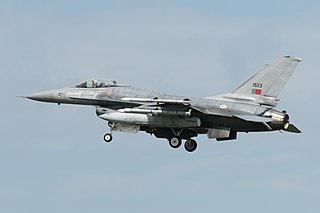
The de Havilland Canada DHC-1 Chipmunk is a tandem, two-seat, single-engined primary trainer aircraft designed and developed by Canadian aircraft manufacturer de Havilland Canada. It was developed shortly after the Second World War and sold in large numbers during the immediate post-war years, being typically employed as a replacement for the de Havilland Tiger Moth biplane.
An Air Experience Flight (AEF) is a training unit of the Royal Air Force Volunteer Reserve whose main purpose is to give introductory flying experience to cadets from the Air Training Corps and the Combined Cadet Force. As of 2019, thirteen AEFs are active.

The Portuguese Air Force is the aerial warfare force of Portugal. Locally it is referred to by the acronym FAP but internationally is often referred to by the acronym PRTAF. It is the youngest of the three branches of the Portuguese Armed Forces.

The Portuguese Naval Aviation constituted the air component of the Portuguese Navy, from 1917 to 1957. The Portuguese Air Force maritime patrol units and the Navy's Helicopter Squadron are the present successors of the former Portuguese Naval Aviation.

The Asas de Portugal was a flight demonstration team created in 1977 integrated with Esquadra 103 of the Portuguese Air Force. It was Portugal's national aerobatic flying team and flew two ex-German Air Force Dassault-Breguet/Dornier Alpha Jets.

A Royal Air Force University Air Squadron recruiting within Scotland, Universities of Glasgow and Strathclyde Air Squadron draws its members from six higher education establishments within Glasgow and its surrounding areas.

Beja Air Base, officially designated as Air Base No. 11 is one of the most important military airbases in Portugal, 9 km (5.6 mi) northwest of Beja, 100 km (62 mi) north of Algarve. It is used by the Portuguese Air Force (PoAF) and has two parallel runways in the 01/19 direction, the biggest being 3,450 m × 60 m. The base is home to two training squadrons, one helicopter squadron and one maritime patrol squadron.

The 752 Squadron "Fénix" is a helicopter Search and Rescue squadron of the Portuguese Air Force, flying the EH101 Merlin helicopter.

The 711 Squadron "Albatrozes" was a flying squadron of the Portuguese Air Force. Its primary mission was Search and Rescue and it has had secondary missions tactical air transport and general air transport in the Azores archipelago. During the time it was active it was the only operational squadron in the Portuguese military to operate both rotary- and fixed-wing aircraft.

The 301 Squadron "Jaguares" is a fighter squadron of the Portuguese Air Force (PoAF).

The 103 Squadron "Caracóis" is a jet advanced training squadron of the Portuguese Air Force. Prior to 1978, the "Caracóis" also received following designations: 22 Squadron, Esquadra de Instrução Complementar de Pilotagem (EICP) and Esquadra de Instrução Complementar de Pilotagem em Aviões de Combate (EICPAC).

No. 1 Flying Training Wing currently based at SLAF China Bay, carries out basic pilot training of the Sri Lanka Air Force. It is the oldest flying formation in the SLAF.

Monte Real Air Base, officially designated as Air Force Base No. 5, is a Portuguese Air Force (PoAF) air base located in Monte Real, Leiria, Portugal. Its mission is to guarantee the readiness and deployment of the air force units based there. Since its opening in October 1959, the base has been home to the air force's jet fighter aircraft, with several of the units based there being equipped with F-86F Sabre, Fiat G.91, T-33 Shooting Star, T-38 Talon and A-7 Corsair II aircraft.

The 502 Squadron "Elefantes" is a transport squadron of the Portuguese Air Force. Its primary mission is tactical air transport and has the secondary mission of providing additional pilot training in multi-engine aircraft and in navigation, search and rescue, and general air transport.

The Air Museum is an aviation museum of the Portuguese Air Force located at Sintra Air Base and with spaces at Ovar and Alverca.

601 Squadron "Lobos" is a maritime patrol and anti-submarine warfare squadron of the Portuguese Air Force (PoAF), currently based at Beja Air Base. It operates the Lockheed P-3C CUP+ Orion.

Sintra Air Base, officially designated as Air Base No. 1, is a Portuguese Air Force base located in the Sintra Municipality, Portugal. The base is home to a flight training squadron and the Portuguese Air Force Academy.

102 Squadron "Panchos" was an elementary flight training squadron of the Portuguese Air Force disbanded in 1992. Formed in 1962, the squadron administered air force training and performed at air shows throughout Portugal. Between 1963 and its disbandment in 1992, the squadron lost nine pilots.

The Portuguese Air Force (PoAF) has operated Sud Aviation Alouette III light utility helicopters since 1963. The Portuguese government originally purchased 142 helicopters to replace the Sud Aviation Alouette II and for use in the roles of tactical transport, medical evacuation, and flight training, with several being adopted for combat air support.

The Military and Technical Training Center of the Air Force or CFMTFA is the unit responsible for the military, humanistic, technical and scientific training of the personnel of the Portuguese Air Force. It is located in Ota, occupying the facilities of the former Ota Air Base.



















